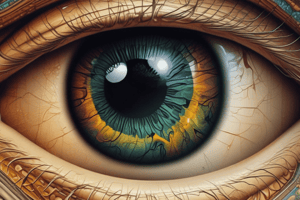Podcast
Questions and Answers
চোখের কোন অংশটি আলোকে প্রথমে কেন্দ্রীভূত করে?
চোখের কোন অংশটি আলোকে প্রথমে কেন্দ্রীভূত করে?
- রেটিনা
- লেন্স
- কর্নিয়া (correct)
- আইরিস
রডস রক্তে বেশি আলোতে কাজ করে।
রডস রক্তে বেশি আলোতে কাজ করে।
False (B)
রেটিনার প্রধান কাজ কী?
রেটিনার প্রধান কাজ কী?
আলোর সংকেত ইলেকট্রিক সংকেতে রূপান্তর করা
আইরিসের কাজ হলো ______ নিয়ন্ত্রণ করা।
আইরিসের কাজ হলো ______ নিয়ন্ত্রণ করা।
নিচে দেওয়া চোখের শর্তগুলোর সাথে তাদের সংজ্ঞা মেলান:
নিচে দেওয়া চোখের শর্তগুলোর সাথে তাদের সংজ্ঞা মেলান:
কোনটি লেন্সের কাজের একটি উদাহরণ?
কোনটি লেন্সের কাজের একটি উদাহরণ?
মিওপিয়া চোখের আকার ছোট হওয়ার কারণে ঘটে।
মিওপিয়া চোখের আকার ছোট হওয়ার কারণে ঘটে।
নির্দেশিত আলোতে কনিস কীভাবে কাজ করে?
নির্দেশিত আলোতে কনিস কীভাবে কাজ করে?
Flashcards
কর্ণিয়া (Cornea)
কর্ণিয়া (Cornea)
চোখের সামনের স্বচ্ছ পৃষ্ঠ যা আলোক রশ্মিকে মোড়ন করে।
পুতুল (Pupil)
পুতুল (Pupil)
চোখের ছাত্র - আলোর পরিমাণ নিয়ন্ত্রণ করে।
আইরিস (Iris)
আইরিস (Iris)
চোখের রঙিন অংশ যা পুতুলের আকার নিয়ন্ত্রণ করে।
লেন্স (Lens)
লেন্স (Lens)
Signup and view all the flashcards
রেটিনা (Retina)
রেটিনা (Retina)
Signup and view all the flashcards
মিওপিয়া (Myopia)
মিওপিয়া (Myopia)
Signup and view all the flashcards
হাইপারোপিয়া (Hyperopia)
হাইপারোপিয়া (Hyperopia)
Signup and view all the flashcards
অস্টিগ্ম্যাটিজম (Astigmatism)
অস্টিগ্ম্যাটিজম (Astigmatism)
Signup and view all the flashcards
Study Notes
Eye Structure and Function
- The eye is a complex sensory organ that converts light into electrical signals interpreted by the brain as images.
- It functions as a camera, focusing light onto a light-sensitive tissue called the retina.
- The eye is composed of several distinct layers and structures that work together to achieve vision.
Key Structures
- Cornea: The transparent front surface of the eye. It acts as the initial focusing element, bending light rays.
- Pupil: The opening in the iris that controls the amount of light entering the eye.
- Iris: The colored part of the eye that regulates the size of the pupil, similar to a camera's aperture.
- Lens: A transparent, flexible structure that further focuses light rays onto the retina. Its shape is adjusted by ciliary muscles for near and far vision (accommodation).
- Retina: The light-sensitive lining of the inner eye. It contains photoreceptor cells (rods and cones) that convert light into nerve signals.
- Rods: Photoreceptor cells responsible for vision in low light conditions. They provide shades of grey.
- Cones: Photoreceptor cells responsible for color vision and sharp detail in bright light, containing different photopigments for different color ranges.
- Optic Nerve: A bundle of nerve fibers that transmits visual information from the retina to the brain.
- Macula: A small, central region of the retina that provides the clearest vision, containing a high concentration of cones.
Vision Mechanisms
- Focusing: The cornea and lens work together to focus incoming light onto the retina.
- Accommodation: The lens's ability to change shape to focus on objects at varying distances.
- Refraction: The bending of light as it passes from one medium to another (e.g., air to cornea).
- Visual Fields: Each eye creates a slightly different view of the world. The brain combines these images to create a single three-dimensional image.
- Phototransduction: The process by which light energy is converted into electrical signals in the photoreceptor cells.
Common Eye Conditions
- Myopia (Nearsightedness): The eye's shape is too long, causing light to focus in front of the retina.
- Hyperopia (Farsightedness): The eye's shape is too short, causing light to focus behind the retina.
- Astigmatism: Uneven curvature of the cornea or lens, causing blurry vision at any distance.
- Presbyopia: Loss of the ability to adjust focus for near vision, often associated with aging.
- Cataracts: Clouding of the lens, impacting vision clarity.
- Glaucoma: Damage to the optic nerve often due to increased intraocular pressure.
Eye Health
- Regular Eye Exams: Crucial for early detection of eye diseases and conditions.
- Eye Protection: Sunglasses and protective eyewear are essential for protecting the eyes from UV radiation and potential injuries.
- Healthy Diet: A balanced diet rich in antioxidants and vitamins can contribute to overall eye health.
- Proper Lighting: Using proper lighting while reading or using computer screens can reduce eye strain.
Studying That Suits You
Use AI to generate personalized quizzes and flashcards to suit your learning preferences.




